
hotline:
17715390137
Tel/Wechat:
18101240246 (Technology)
0512-68565571
Email:mxenes@163.com (Sales Engineer)bkxc.bonnie@gmail.com
Scan the code to follow or search the official account on WeChat:
2D Materials Fronrier After paying attention,
click on the lower right corner to contact us,
Enter enterprise WeChat.
Professional Services Online

已传文件:photo/20203129587412.png
Professor Wang Guoxiu received his Ph.D. from Wollongong University in Australia in 2001 and stayed in the university as a senior lecturer and associate professor. In 2010, he was employed as a professor at the University of Technology Sydney, and established the Clean Energy Technology Centre as the director of the centre. Professor Wang is dedicated to the research and development of energy materials, and has achieved excellent results in many interdisciplinary fields including materials engineering, materials chemistry, electrochemical energy storage conversion, nanotechnology, and synthesis and manufacturing of advanced materials. Professor Wang presided over more than 20 projects of the Australian Funding Commission and the industry. So far, Professor Wang has published more than 460 SCI papers, cited more than 25,000 times, and an h-factor of 85. In 2018, he was a highly-cited scientist in the dual disciplines of Materials and Chemistry (Web of Science / Clarivate Analytics). FRSC), ISE fellow.
Link to the website of the research group: https://www.uts.edu.au/research-and-teaching/our-research/centre-clean-energy-technology
The research results of Professor Wang Guoxiu and his research team in 2018 are collated to facilitate everyone to fully understand the research progress.
1.Nature Catalysis: Pt monoatomic Mxene catalyst is used to greatly improve the performance of electrocatalytic hydrogen evolution

So far, Pt is considered to be one of the most active HER catalytic materials, while monoatomic Pt catalysts have shown lower cost and superior activity. How to prepare excellent monoatomic Pt catalysts to achieve higher activity HER performance is a key issue in the fields of catalysis and energy research. Professor Wang Guoxiu‘s team, Yury Gogotsi‘s team at Drexel University, and Li Yadong and Chen Chen‘s team at Tsinghua University jointly published a study entitled "Single platinum atoms immobilized on an MXene as an efficient catalyst for the hydrogen evolution reaction" on Nature Catalysis. In the thesis, a strategy for electrochemical in situ synthesis of MXene-supported monoatomic Pt catalysts was proposed, and at the same time, efficient hydrogen production performance was achieved. The article points out that during the electrochemical stripping of MXene in an acidic system, H + interacts with the Mo-O bond on the surface of MXene, on the one hand, it can efficiently produce hydrogen and promote the stripping to obtain nanosheets. On the other hand, the bond between H + and Mo-O generates Mo-OH2 groups, forms Mo vacancies, and finally obtains Mo2TiC2Tx-Pt single-atom catalyst. In summary, studies show that H + in acidic systems promotes the formation of electrochemically stripped MXene nanosheets and the synthesis of monoatomic Pt-supported catalysts.
Literature link: https://www.nature.com/articles/s41929-018-0195-1
Single platinum atoms immobilized on an MXene as an efficient catalyst for the hydrogen evolution reaction. (Nature Catalysis, 2018, DOI: 10.1038 / s41929-018-0195-1)
2.Nature Communications: Stable room temperature sodium-sulfur battery

High-temperature sodium-sulfur batteries operating at 300-350 ° C have been commercialized for large-scale energy storage and conversion. However, security issues have greatly inhibited their widespread adoption. To this end, Professor Wang Guoxiu‘s team and the team of Professor Li Baohua of Tsinghua University and the team of Professor Michel Armand of the CIC ENERGIGUNE Institute in Spain jointly published a title entitled "A room-temperature sodium-sulfur battery with high capacity and stable cycling performance" on Nature Communications. The research paper reports a high-performance room temperature sodium-sulfur battery using a "cocktail-optimized" electrolyte system. The electrolyte uses propylene carbonate and fluoroethylene carbonate as co-solvents, and high-concentration sodium salt and indium iodide as additives. First-principles calculations and experimental characterizations confirm that fluoroethylene carbonate solvents and high salt concentrations not only greatly reduce the solubility of sodium polysulfides, but also build a solid solid polymer electrolyte (SEI) on the sodium anode during cycling. membrane. Indium iodide as a redox medium not only increases the kinetic conversion of sodium sulfide on the positive electrode, but also forms an indium passivation layer on the negative electrode to prevent it from being corroded by sodium polysulfide. The sodium-sulfur battery has high capacity and long-cycle stability, and provides a new way for the development of low-cost and high-performance room-temperature sodium-sulfur batteries.
Literature link: https://www.nature.com/articles/s41467-018-06443-3
A room-temperature sodium-sulfur battery with high capacity and stable cycling performance. (Nature Communications, 2018, DOI: 10.1038 / s41467-018-06443-3)
3.Nature Communications: Multifunctional functionalized ionic liquid used to improve lithium-oxygen battery solution mediation
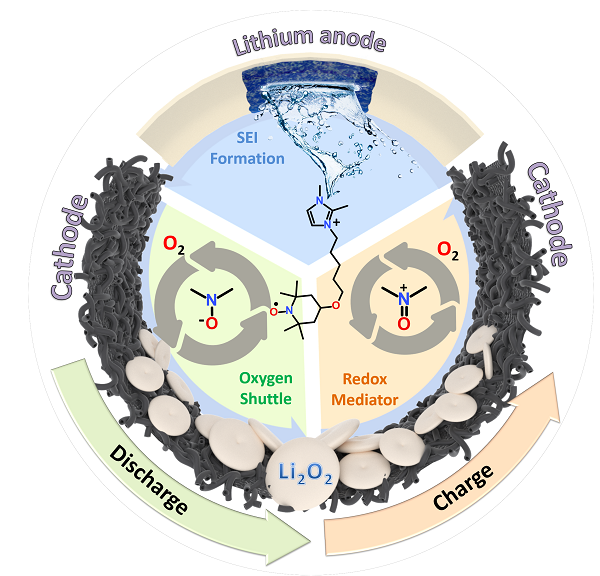
The large overpotential of a lithium-oxygen battery during a charge-discharge cycle results in the formation of by-products and a short cycle life. Professor Wang Guoxiu‘s team and the Peng Zhangquan team of the Changchun Institute of Applied Chemistry of the Chinese Academy of Sciences and the team of Professor Michel Armand of the CICENERGIGUNE Institute of Spain jointly published a study entitled "A versatile functionalized ionic liquid to comprehensively boost the solution-mediated performances of lithium-oxygen batteries" on Nature Communications. Thesis, with a redox-active 2,2,6,6-tetramethyl-1-piperidinyloxy moiety, a multifunctional TEMPO grafted ionic liquid (IL-TEMPO), with a redox mediator, oxygen Various functions of shuttle, lithium metal protective additive and electrolyte solvent. Among them, n- / p-doping makes IL-TEMPO play the role of redox mediator and oxygen shuttle. Compared with the pure ether-based electrolyte, the discharge capacity is increased by 33 times, and the overpotential is reduced to an extremely low value of 0.9V. The ionic liquid also forms a stable SEI to suppress side reactions and ensure smooth lithium stripping / plating. The proportion of ionic liquid in the electrolyte affects the reaction mechanism. At high concentrations, amorphous Li2O2 is formed as a discharge product, resulting in a long cycle life (> 200 cycles). In addition, the unique properties of IL-TEMPO enable the battery to have excellent electrochemical performance in harsh environments, such as at a high temperature of 70 ° C or in an air atmosphere.
Literature link: https://www.nature.com/articles/s41467-019-08422-8
A versatile functionalized ionic liquid to comprehensively boost the solution-mediated performances of lithium-oxygen batteries. (Nature Communications, 2018, DOI: 10.1038 / s41467-019-08422-8)
4.Advanced Materials: Application of a non-dendritic metal sodium anode in high energy density batteries
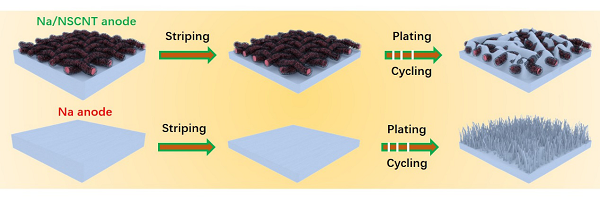
Professor Wang Guoxiu‘s team collaborated with Professor Wang Dan of the Institute of Process Engineering of the Chinese Academy of Sciences to jointly publish a research paper entitled "Dendrite-free sodium-metal anodes for high-energy sodium-metal batteries" on Advanced Materials, and proposed a metal-inhibitory A New Strategy for Sodium Negative Dendritic Growth. Sodium metal is one of the most promising electrode materials for the next generation of low-cost rechargeable batteries. However, safety issues caused by the dendrite growth of the sodium metal negative electrode limit the practical application of rechargeable sodium metal batteries. In this paper, paper made from nitrogen and sulfur co-doped carbon nanotubes (NSCNT) was used to control sodium nucleation behavior and inhibit sodium dendrite growth. The functional groups containing nitrogen and sulfur on the carbon nanotubes make the NSCNT paper highly "sodium-philic", which can regulate the initial sodium nucleation behavior and guide the uniform distribution of sodium on the NSCNT paper. The experimental results show that the metal sodium / NSCNT paper composite negative electrode exhibits no dendritic morphology and excellent cycle stability during repeated sodium deposition and peeling processes. The cycle stability of the sodium / oxygen battery using the composite negative electrode is significantly improved. This work opens a new path for the development of the next generation of high-energy-density sodium metal batteries.
Literature link: https://onlinelibrary.wiley.com/doi/abs/10.1002/adma.201801334
Dendrite-free sodium-metal anodes for high-energy sodium-metal batteries. (Advanced Materials, 2018, DOI: 10.1002 / adma.201801334)
5. Advanced Energy Materials: K1.39Mn3O6 microspheres coated with aluminum fluoride as super high performance potassium ion battery

Professor Wang Guoxiu‘s team published a research paper titled "Construction of Hierarchical K1.39Mn3O6 Spheres via AlF3 Coating for High-Performance Potassium-Ion Batteries" on Advanced Energy Materials. For the first time, an AlF3 surface coating strategy was successfully used to prepare a novel K1.39Mn3O6 microsphere cathode material with excellent electrochemical performance. When it is used as a positive electrode material of a potassium ion battery, it exhibits excellent rate performance and cycle stability. Finally, the authors used the ectopic XRD measurement technique to record the changes in the XRD diffraction peak positions during sample charging and discharging. The experimental results show that the (4 0 1) and (-3 1 3) crystal planes of the synthesized positive electrode material are coated with AlF3 and the change trend of crystal planes is weakened, and the (-1 1 2) crystal plane is irreversible when first discharged to 2.14V The structural change is suppressed, so the volume expansion of the positive electrode material of the potassium ion battery during the charge and discharge process is greatly reduced. Helps improve the rate performance and cycle stability of the material.
Literature link: https://onlinelibrary.wiley.com/doi/10.1002/aenm.201803757
Construction of Hierarchical K1.39Mn3O6 Spheres via AlF3 Coating for High-Performance Potassium-Ion Batteries. (Advanced Energy Materials, 2019, DOI: 10.1002 / aenm.201803757)
6. Advanced Energy Materials: Application of Co-B nanosheets / ZnCo2O4 micro / nanospheres in lithium storage
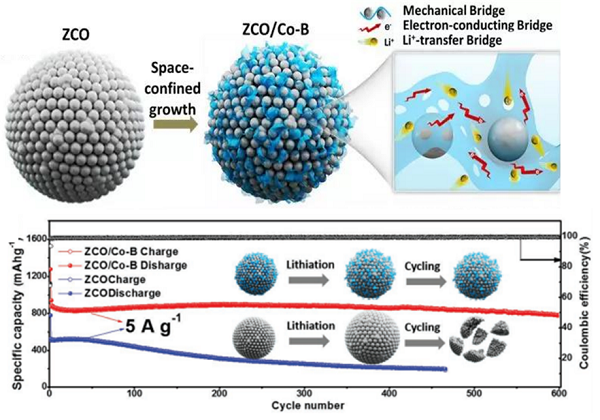
Professor Wang Guoxiu‘s team and Professor Li Baohua‘s team at Tsinghua University co-published a research paper entitled "Co-B nanoflakes as multi-functional bridges in ZnCo2O4 micro- / nanospheres for superior lithium storage with boosted kinetics and stability" on Advanced Energy Materials. The ZnCo2O4 / Co-B (ZCO / Co-B) composite was successfully synthesized by a simple one-step solution method. When used in lithium-ion batteries, they all show excellent rate and cycle performance. The kinetic analysis revealed that the external pseudocapacitive behavior can increase the charge transfer rate during lithium ion insertion and extraction. Further theoretical calculations show that the ZCO / Co-B heterogeneous interface can reduce the lithium ion diffusion energy barrier and accelerate lithium ions. Migration helps to improve the rate performance and cycle stability of the material.
Literature link: https://onlinelibrary.wiley.com/doi/abs/10.1002/aenm.201803612?af=R
Co-B nanoflakes as multi-functional bridges in ZnCo2O4 micro / nanospheres for superior lithium storage with boosted kinetics and stability. (Advanced Energy Materials, 2019, DOI: 10.1002 / aenm.201803612)
7. Advanced Energy Materials: New high-performance superelectric materials: Anthraquinone-2-sulfonate (AQS) / rGO composite electrode
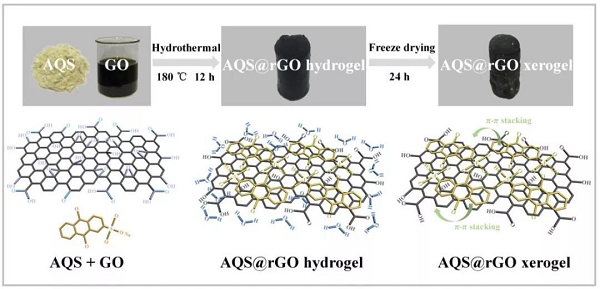
Professor Wang Guoxiu‘s team and Professor Li Baohua‘s team at Tsinghua University co-published a research paper entitled "Redox-Active Organic Sodium Anthraquinone-2-Sulfonate (AQS) Anchored on Reduced Graphene Oxide for High-Performance Supercapacitors" on Advanced Energy Materials. First research on sodium anthraquinone-2-sulfonate (AQS) as an organic redox active material, and adding graphene nanosheets with high conductivity to improve electronic conductivity; the -SO3- functional group of AQS has excellent hydrophilic It promotes the recombination of AQS and reduced graphene oxide (rGO) at the molecular level and forms an interconnected three-dimensional xerogel (AQS @ rGO). The composite material has a high specific capacitance of 567.1 F / g at a current density of 1 A / g, and can maintain a specific capacity of 89.1% after 10 A / g cycles of 10,000 cycles. First-principles calculations show that the interaction between AQS and rGO forms a space charge layer, which greatly promotes the electron transfer between the two and the exertion of AQS specific capacity. This work opens a new way for the development of high-performance supercapacitor electrode materials.
Literature link: https://onlinelibrary.wiley.com/doi/abs/10.1002/aenm.201802088
Redox-Active Organic Sodium Anthraquinone-2-Sulfonate (AQS) Anchored on Reduced Graphene Oxide for High-Performance Supercapacitors. (Advanced Energy Materials, 2018, DOI: 10.1002 / aenm.201802088)
8. Advanced Energy Materials: Nitrogen-doped MXene nanosheets used as sulfur-fixing host materials for lithium-sulfur batteries
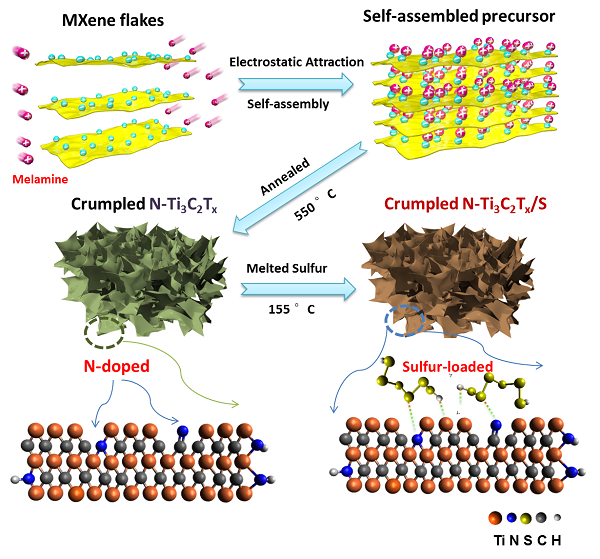
Professor Wang Guoxiu‘s team collaborated with a researcher team of Dan Wang from the Institute of Process Engineering of the Chinese Academy of Sciences to jointly publish a research paper entitled "Facile Synthesis of Crumpled Nitrogen-Doped MXene Nanosheets as a New Sulfur Host for Lithium-Sulfur Batteries" on Advanced Energy Materials. In this work, foldable N-doped MXene nanosheets were synthesized by a simple one-step synthesis method and used as a sulfur-fixing host material. This strategy forms a porous structure and high specific surface area of MXene while introducing N-doping heteroatoms. The prepared N-doped MXene nanosheets have strong physical and chemical double adsorption capacity for polysulfides, and have a high sulfur loading (5.1 mg cm-2). The composite cathode based on wrinkled N-doped MXene / S exhibits excellent electrochemical performance. It has a high specific capacity of 1144 mAh g-1 at 0.2C and 610 mAh g-1 after 1000 cycles at 2C current density. , Has better cycle stability.
Literature link: https://onlinelibrary.wiley.com/doi/abs/10.1002/aenm.201702485
Facile Synthesis of Crumpled Nitrogen-Doped MXene Nanosheets as a New Sulfur Host for Lithium-Sulfur Batteries. (Advanced Energy Materials, 2018, DOI: 10.1002 / aenm.201702485)
9.Journal of the American Chemical Society: Limited to Mxene (Ti3C2) vacant monoatomic catalysts for efficient functional catalysis of carbon dioxide

A central issue in monoatomic catalysis is the establishment of strong interactions between single atoms and stable support. Chen Chen‘s team from Tsinghua University and Professor Wang Guoxiu‘s team published a research paper entitled "MXene (Ti3C2) Vacancy Confined Single-Atom Catalyst for Efficient Functionalization of CO2" in the Journal of the American Chemical Society. They reported on the use of ultra-thin The two-dimensional Ti3-xC2Ty MXene nanosheets are stable monoatomic catalysts prepared by a self-reduction stabilization method, which is characterized by rich Ti defect vacancy defects and high reduction ability. The single atom in it forms a strong metal-carbon bond with the Ti3-xC2Ty support and stabilizes it in the position previously occupied by Ti. The Pt-based monoatomic catalyst Pt1 / Ti3-xC2Ty provides a green way to consume greenhouse gas CO2 through the formylation of amines as the C1 source in organic synthesis. DFT calculations show that compared to Pt nanoparticles, a single Pt atom on Ti3-xC2Ty supports partial positive charge and atomic dispersion, which helps to significantly reduce the adsorption and activation energy of silane, CO2, and aniline, thereby improving catalytic performance .
Literature link: https://pubs.acs.org/doi/10.1021/jacs.8b13579
MXene (Ti3C2) Vacancy Confined Single-Atom Catalyst for Efficient Functionalization of CO2. (Journal of the American Chemical Society, 2019, DOI: 10.1021 / jacs.8b13579)
10.ACS Nano: single-layer titanium oxide (Ti0.87O2) nanosheets and nitrogen-doped graphene nanosheets with superlattice structure for negative electrode of sodium ion battery
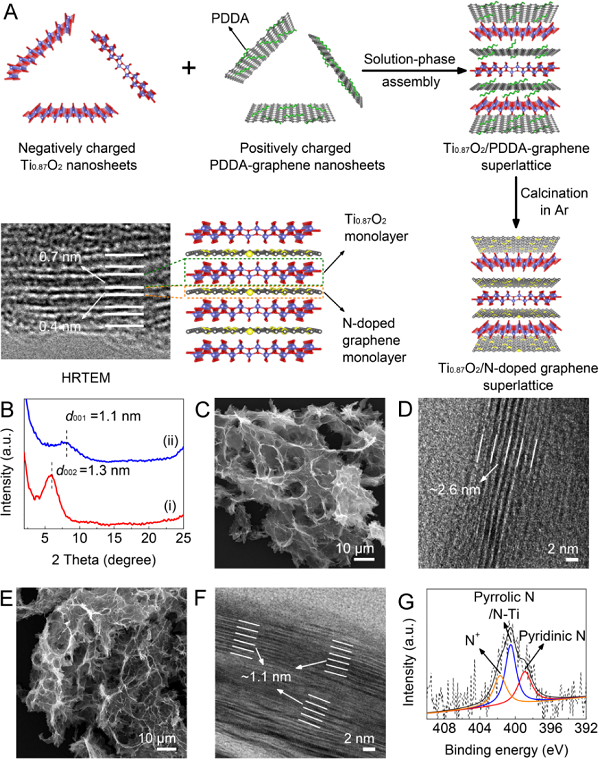
Prof. Wang Guoxiu‘s team, Prof. Takayoshi Sasaki from the National Institute of Materials Research (NIMS) and Prof. Michel Armand from the CIC Energigune Research Institute of Spain jointly published on ACS Nano the title "Two-Dimensional Unilamellar Cation-Deficient Metal Oxide Nanosheet Superlattices for High-Rate Sodium Ion Energy Storage "research paper, co-reported a superlattice structure based on single-layer titanium oxide (Ti0.87O2) nanosheets with nitrogen vacancies and nitrogen-doped graphene nanosheets, and applied it to sodium The negative electrode of an ion battery exhibits ultra-high specific capacity, excellent low-temperature rate performance and cycle performance. Compared with three-dimensional structures and sheet-like nanomaterials, these truly single-layer nanosheets allow all cation vacancies to be effectively used, providing additional intercalation sites for storage of Na ions. This work provides new ideas for 2D material defect engineering and promotes the development of efficient electrochemical energy storage technology.
Literature link: https://pubs.acs.org/doi/10.1021/acsnano.8b06206
Two-Dimensional Unilamellar Cation-Deficient Metal Oxide Nanosheet Superlattices for High-Rate Sodium Ion Energy Storage. (ACS Nano, 2018, DOI: 10.1021 / acsnano.8b06206)
11.Chem: Graphite-phase carbon nitride nanosheets as metal-free photocatalyst

Compared with traditional technologies such as ultraviolet disinfection, chlorination disinfection and ozone disinfection, water purification using solar photocatalytic disinfection is undoubtedly more energy-saving, economical and environmentally friendly, and it is expected to significantly alleviate the international problem of shortage of clean water. Professor Wang Guoxiu‘s team and Professor Wang Yi‘s team of Yangzhou University and Wang Dan‘s researcher team at the Chinese Academy of Sciences jointly published a research paper entitled "Edge-Functionalized g-C3N4 Nanosheets as a Highly Efficient Metal-free Photocatalyst for Safe Drinking Water" A non-metallic catalyst, a graphitic carbon nitride (g-C3N4) nanosheet modified with a fixed-point modification, was reported. Can quickly kill bacteria in the water (log disinfection efficiency = 6) and meet national drinking water standards. In order to gain a deeper understanding of the mechanism of photocatalytic disinfection, the authors studied the steady-state reactive oxygen species (ROS) concentrations in the system by sequential quenching, namely 1O2, • O2-, • OH, and H2O2. Experiments show that under the sunlight (removing ultraviolet light), the edge-modified g-C3N4 can photocatalyze to generate more • O2-, and it is a vital active intermediate in the process of generating H2O2. The authors use density functional theory to study the charge distribution of edge-modified g-C3N4 nanosheets, and theoretically prove that edge modification will lead to stronger oxygen adsorption.
Literature link: https://www.sciencedirect.com/science/article/pii/S2451929418305722
Edge-Functionalized g-C3N4 Nanosheets as a Highly Efficient Metal-free Photocatalyst for Safe Drinking Water. (Chem, 2019, DOI: 10.1016 / j.chempr.2018.12.009)
12.Angewandte Chemie International Edition: High-performance quasi-solid-state room temperature sodium-sulfur battery
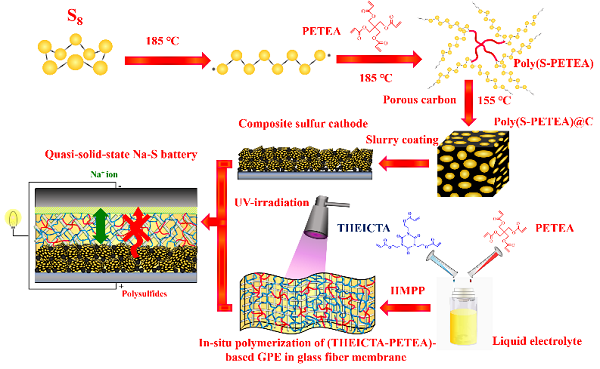
Professor Wang Guoxiu‘s team and Professor Li Baohua‘s team of Tsinghua University and the team of Professor Michel Armand of the CIC ENERGIGUNE Institute in Spain jointly published a research paper entitled "A Stable Quasi-Solid-State Sodium–Sulfur Battery" in Angewandte Chemie International Edition. A stable quasi-solid-state room-temperature sodium-sulfur battery composed of a sodium metal negative electrode, a poly (sulfur-pentaerythritol tetraacrylate (PETEA))-based positive electrode, and (PETEA-tris [2- (acryloyloxy) ethyl] isocyanate) Ureate (THEICTA)) gel polymer electrolyte composition. The polymer sulfur electrode strongly anchors sulfur and inhibits the shuttle effect through chemical bonding. At the same time, the polymer electrolyte formed in situ with high ionic conductivity and safety successfully stabilized the sodium anode / electrolyte interface and further suppressed the dissolution and diffusion of sodium polysulfide. This dual optimization of the cathode material and the electrolyte enables stable cycling of quasi-solid-state sodium-sulfur batteries with high energy density, and provides new ideas for the development of room-temperature sodium-sulfur batteries.
Literature link: https://onlinelibrary.wiley.com/doi/abs/10.1002/anie.201805008
A Stable Quasi‐Solid‐State Sodium–Sulfur Battery. (Angewandte Chemie International Edition, 2018, DOI: 10.1002 / anie.201805008)
13.Nano Energy: Simple in situ film formation inhibits sodium anode growth
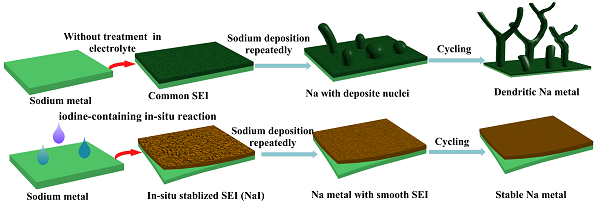
High-capacity sodium metal anodes provide new opportunities for developing the next generation of rechargeable batteries with high power and high energy density. However, many challenges still plague sodium metal batteries, including lower coulomb efficiency and sodium dendrites generated after repeated charge and discharge, which causes safety issues. In particular, compared with lithium metal anodes, sodium metal anodes have lower stability in organic electrolyte (such as carbonates) systems and are prone to the formation of sodium dendrites. Professor Wang Guoxiu‘s team published a research paper entitled "Ultra-stable Sodium Metal-iodine Batteries Enabled by An In-situ Solid Electrolyte Interphase" on Nano Energy, reporting a simple in-situ film formation technique to stabilize sodium metal anodes and Inhibits the growth of sodium dendrites. Based on the NaI SEI layer generated by the in situ iodination reaction, the research team successfully prepared a sodium iodide metal battery with excellent performance (> 2200 cycles). This sodium-iodine metal battery has a higher discharge voltage (> 2.7 V), high capacity (210 mAh / g at 0.5C), and has a faster charge transfer kinetic interface and lower overpotential (134 mV). This work provides new ideas for designing low-cost, high-performance and high-safety sodium iodine batteries and other iodine-based batteries.
Literature link: https://www.sciencedirect.com/science/article/pii/S2211285518309972
Ultra-stable Sodium Metal-iodine Batteries Enabled by An In-situ Solid Electrolyte Interphase. (Nano Energy, 2018, DOI: 10.1016 / j.nanoen.2018.12.084)
14.Joule: Aerogel-like porous Mxene for desalination

Professor Wang Guoxiu‘s team and Professor Yury Gogotsi‘s team at Drexel University jointly published a research paper entitled "Porous Cryo-Dried MXene for Efficient Capacitive Deionization" in Joule. The researchers were inspired by the research of energy storage electrode materials. They designed and prepared a CDI device with aerogel-like porous MXene as a carrier. The device performs well in high solution salinity and can provide extremely high electrosorption. Ability to obtain a high adsorption capacity of 118 mg / cm2 in extremely high-concentration brine (10000 mg / liter), which is an order of magnitude higher than that of traditional carbon-based electrode materials. The porous MXene-CDI device has significantly improved the adsorption efficiency of CDI technology, making the development of CDI technology into a new stage of industrial-scale desalination.
Literature link: https://www.cell.com/joule/fulltext/S2542-4351(18)30087-4
Porous Cryo-Dried MXene for Efficient Capacitive Deionization. (Joule, 2018, DOI: 10.1016 / j.joule.2018.02.018)
15.Advanced Functional Materials Overview: Status, Challenges and Prospects of Li2S Cathode and Its Ultra High Performance Lithium-Sulfur Battery
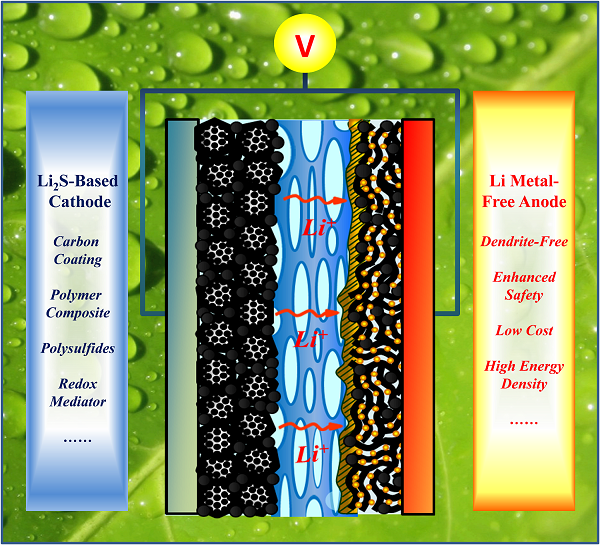
As a new-generation rechargeable battery system with high energy density and low cost, lithium-sulfur (Li-S) batteries have attracted increasing interest. If the problem of polysulfide shuttle effect is solved, lithium-sulfur batteries will realize their theoretical potential. Therefore, great efforts have been made to overcome this problem in terms of the physical limitations and chemisorption of polysulfides. Recently, it was found that replacing sulfur cathodes with lithium sulfide (Li2S) can not only largely avoid volume expansion problems during cycling, but also work with anode materials other than lithium metal to eliminate the seriousness of traditional Li-S batteries safe question. However, because Li2S-based cathode materials are sensitive to humidity and pre-lithiation of non-Li metal anode materials is often required in practical applications, developing practical Li-free metal Li-S battery systems faces many challenges. Professor Wang Guoxiu‘s team published a review paper entitled "Toward High Performance Lithium-Sulfur Batteries Based on Li2S Cathodes and Beyond: Status, Challenges, and Perspectives" in Advanced Functional Materials, reviewing the latest progress of Li-S batteries based on Li2S cathodes. It features improved safety, high coulomb efficiency and high energy density. The electrode activation process was also discussed, which is critical to achieving high performance. Extensive efforts are expected to bring breakthroughs to the development of Li2S cathode-based Li-S batteries.
Literature link: https://onlinelibrary.wiley.com/doi/abs/10.1002/adfm.201800154
Toward High Performance Lithium-Sulfur Batteries Based on Li2S Cathodes and Beyond: Status, Challenges, and Perspectives. (Advanced Functional Materials, 2018, DOI: 10.1002 / adfm.201800154)
16. Overview of Advanced Energy Materials: Improved metal compounds (MOFs, -S, -OH, -N, -C) as anode materials for Li-S batteries

Lithium-sulfur (Li-S) batteries have the same high-efficiency and extensive potential as lithium-ion (Li-ion) batteries, because sulfur electrodes have high theoretical capacity (1672 mA h g-1) and are affordable. However, commercialization of Li-S batteries is difficult to achieve. The shuttle effect of polysulfides inevitably leads to capacity decay. At present, people mostly solve this problem through physical limitation and chemical adsorption of polysulfides. Due to weak intermolecular interactions, physical confinement strategies do not work during long-term battery cycling. Chemisorption originates from polar interactions, Lewis acid-base interactions and sulfur chain connections significantly inhibit the shuttle effect of polysulfides. Researchers also found that metal compounds have strong chemical interactions with polysulfides. Professor Wang Guoxiu‘s team published a review paper entitled "Updated Metal Compounds (MOFs, -S, -OH, -N, -C) Used as Cathode Materials for Lithium-Sulfur Batteries" in Advanced Energy Materials, focusing on metal organic framework Sulfides, metal hydroxides, metal nitrides, metal carbides, and discusses how chemical interactions can be combined with the unique properties of these metal compounds to solve the problem of polysulfide shuttle effects.
Literature link: https://onlinelibrary.wiley.com/doi/abs/10.1002/aenm.201702607
Updated Metal Compounds (MOFs, -S, -OH, -N, -C) Used as Cathode Materials for Lithium–Sulfur Batteries. (Advanced Energy Materials, 2018, DOI: 10.1002 / aenm.201702607)
17. Overview of Advanced Energy Materials: 2D MXenes as high-performance electrode materials for lithium ion and lithium sulfur batteries

MXenes has the characteristics of excellent mechanical strength, high specific surface area, high electrical conductivity, and various surface functional groups. At the same time, it also has the advantages of flexible composition adjustment and controllable layer thickness. Great potential. Therefore, Professor Wang Guoxiu‘s team published a review paper entitled "2D Metal Carbides and Nitrides (MXenes) as High-Performance Electrode Materials for Lithium-Based Batteries" on Advanced Energy Materials, summarizing the etching method, structure and physical and chemical properties of MXenes. And its application in the field of lithium ion batteries and lithium sulfur batteries, and put forward some suggestions and prospects for the research of MXenes in the field of energy storage.
Literature link: https://onlinelibrary.wiley.com/doi/full/10.1002/aenm.201801897
Updated Metal Compounds (MOFs, -S, -OH, -N, -C) Used as Cathode Materials for Lithium--Sulfur Batteries. (Advanced Energy Materials, 2018, DOI: 10.1002 / aenm. 10.1002 / aenm.201801897)
Source of information: material cattle

| Reminder: Beijing Beike New Material Technology Co., Ltd. supplies products only for scientific research, not for humans |
| All rights reserved © 2019 beijing beike new material Technology Co., Ltd 京ICP备16054715-2号 |